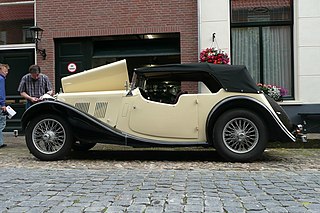The Adamson was an English car manufactured in Enfield, Middlesex, from 1912 to 1925. It was designed by Reginald Barton Adamson at the premises of the family haulage contract business.

Tiny was a British cyclecar manufactured by Nanson, Barker & Co at Esholt, Yorkshire between 1912 and 1915.

Bédélia was the archetype of the French cyclecars.

Albion Motors was a Scottish automobile and commercial vehicle manufacturer.
The Barnard was a British cyclecar manufactured by A Ward of Whitechapel Road, London, between 1921 and 1922.

Coventry Premier Limited owned a British car and cyclecar manufacturing business based in Coventry from 1912 to 1923. It changed its name from Premier Cycles to Coventry Premier Ltd in November 1914.

The Leyland Eight was a luxury car produced by Leyland Motors from 1920 to 1923.

The Bow-V-Car was an English cyclecar manufactured from 1922 to 1923 by the Plycar Company of Church Road, Upper Norwood, London. The car was designed by Charles Frederick Beauvais who was later better known as a stylist working for coachbuilders New Avon Body Company.

Douglas was a British motorcycle manufacturer from 1907–1957 based in Kingswood, Bristol, owned by the Douglas family, and especially known for its horizontally opposed twin cylinder engined bikes and as manufacturers of speedway machines. The company also built a range of cars between 1913 and 1922.
The Rover 8 was a small single-cylinder eight-horsepower 1327 cc car made by the British Rover car company. It was Rover's first production car. It was remarkable for having a backbone rather than a chassis. The first model was manufactured from 1904 to 1912, A Daimler-Knight sleeve-valve engine option was available in 1911 and 1912.
The Perry was a British car made by the Perry Motor Company based in Tyseley, Birmingham who made cars between 1913 and 1916.

The Tamplin was an English automobile manufactured by Tamplin Motors from 1919 to 1923 in Kingston Road, Staines, Middlesex and from 1924 to 1925 in Malden Road, Cheam, Surrey.

The Castle Three was a British three-wheeled cyclecar made from 1919 to 1922 by the Castle Motor Company of Castle Mill Works, New Road, Kidderminster, Worcestershire.
The Palmerston was a British car made by the Palmerston Motor Company based in Bournemouth, England between 1920 and 1923.

The Tatra 30 is an automobile formerly made by the Czech manufacturer Tatra. It was manufactured between 1926 and 1928. From 1928 to 1931 the car was fitted with newer engine and is therefore called Tatra 30/52.

The Little Midland or LM was a British 4-wheeled cyclecar made from 1910 to 1922 by the Little Midland Light Car Co Ltd in various places in Lancashire.
Beacon Motors Ltd was a British automobile manufacturer based in Hindhead, Surrey from 1912-1913 moving to Liphook, Surrey until 1914.
The Day-Leeds was a British automobile manufactured by Job Day & Sons of Leeds, Yorkshire.

The Cluley was a British automobile manufactured between 1921 and 1928 by Clarke, Cluley & Co based in Coventry.

The Autocrat was a British car manufacturer operating from 1913 to 1926. The company operated from premises in the Balsall Heath area of Birmingham. Unusually for the time the company seems to have been run by two women, Ivy Rogers and Miss Howell.
















